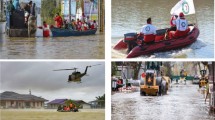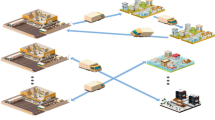Abstract
Optimizing the distribution and allocation of resources among individuals is one of the most important measures to be taken at the time of crisis. Time, as a vital factor, has a significant impact on the increase in the number of people rescued by relief activities. This paper presents an allocation and routing model for relief vehicles in the areas affected by a disaster. It uses a covering tour approach to reduce response time. Moreover, because determining the exact amount of demand for essential goods in the event of a disaster is very difficult and even impossible in some cases, the demand parameter is considered as a fuzzy parameter in this model. Accordingly, an optimization method is designed based on credibility theory, and a harmony search algorithm with random simulation is developed. Finally, the efficiency of the harmony search algorithm is analyzed by comparing the CPLEX solver and GRASP algorithm. The results show that the proposed algorithm performs well over a short operating time.












Similar content being viewed by others

References
Knott, R.: The logistics of bulk relief supplies. Disasters. 11(2), 113–115 (1987)
Barbarosoğlu, G., Özdamar, L., Cevik, A.: An interactive approach for hierarchical analysis of helicopter logistics in disaster relief operations. Eur. J. Oper. Res. 140(1), 118–133 (2002)
Özdamar, L., Ekinci, E., Küçükyazici, B.: Emergency logistics planning in natural disasters. Ann. Oper. Res. 129(1–4), 217–245 (2004)
Ozdamar, L.: Planning helicopter logistics in disaster relief. OR Spectr. 33(3), 655–672 (2011)
Wohlgemuth, S., Oloruntoba, R., Clausen, U.: Dynamic vehicle routing with anticipation in disaster relief. Socio Econ. Plan. Sci. 46(4), 261–271 (2012)
Jang, H.-C., Lien, Y.-N., Tsai, T.-C.: Rescue information system for earthquake disasters based on MANET emergency communication platform. In: Proceedings of the 2009 International Conference on Wireless Communications and Mobile Computing: Connecting the World Wirelessly, ACM, pp. 623–627 (2009)
Zhu, J., Huang, J., Liu, D., Han, J.: Resources allocation problem for local reserve depots in disaster management based on scenario analysis. In: The 7th International Symposium on Operations Research and its Applications. Lijiang, China, pp. 395–407 (2008)
Shen, Z., Dessouky, M.M., Ordóñez, F.: A two-stage vehicle routing model for large-scale bioterrorism emergencies. Networks. 54(4), 255–269 (2009)
Najafi, M., Eshghi, K., Dullaert, W.: A multi-objective robust optimization model for logistics planning in the earthquake response phase. Transport. Res. E-Log. 49(1), 217–249 (2013)
Naji-Azimi, Z., Renaud, J., Ruiz, A., Salari, M.: A covering tour approach to the location of satellite distribution centers to supply humanitarian aid. Eur. J. Oper. Res. 222(3), 596–605 (2012)
Li, X., Ramshani, M., Huang, Y.: Cooperative maximal covering models for humanitarian relief chain management. Comput. Ind. Eng. 119, 301–308 (2018)
Alinaghian, M., Goli, A.: Location, allocation and routing of temporary health centers in rural areas in crisis, solved by improved harmony search algorithm. International Journal of Computational Intelligence Systems. 10(1), 894–913 (2017)
Raziei, Z., Tavakkoli-Moghaddam, R., Rezaei-Malek, M., Bozorgi-Amiri, A., Jolai, F.: Postdisaster relief distribution network design under disruption risk: a tour covering location-routing approach. In: Integrating Disaster Science and Management. Elsevier, pp. 393–406 (2018)
Tirkolaee EB, Goli A, Bakhsi M, Mahdavi I. A robust multi-trip vehicle routing problem of perishable products with intermediate depots and time windows. Numerical Algebra, Control & Optimization. 2017;7:417-33.
Mahdavi, M., Fesanghary, M., Damangir, E.: An improved harmony search algorithm for solving optimization problems. Appl. Math. Comput. 188(2), 1567–1579 (2007)
Geem, Z.W., Lee, K.S., Park, Y.: Application of harmony search to vehicle routing. Am. J. Appl. Sci. 2(12), 1552 (2005)
Goli A, Tirkolaee EB, Malmir B, Bian G-B, Sangaiah AK. A multi-objective invasive weed optimization algorithm for robust aggregate production planning under uncertain seasonal demand. Computing. 2019:1-31.
Tirkolaee EB, Goli A, Hematian M, Sangaiah AK, Han T. Multi-objective multi-mode resource constrained project scheduling problem using Pareto-based algorithms. Computing. 2019:1-24.
Author information
Authors and Affiliations
Corresponding author
Additional information
Publisher’s Note
Springer Nature remains neutral with regard to jurisdictional claims in published maps and institutional affiliations.
Rights and permissions
About this article
Cite this article
Goli, A., Malmir, B. A Covering Tour Approach for Disaster Relief Locating and Routing with Fuzzy Demand. Int. J. ITS Res. 18, 140–152 (2020). https://doi.org/10.1007/s13177-019-00185-2
Received:
Revised:
Accepted:
Published:
Issue Date:
DOI: https://doi.org/10.1007/s13177-019-00185-2



